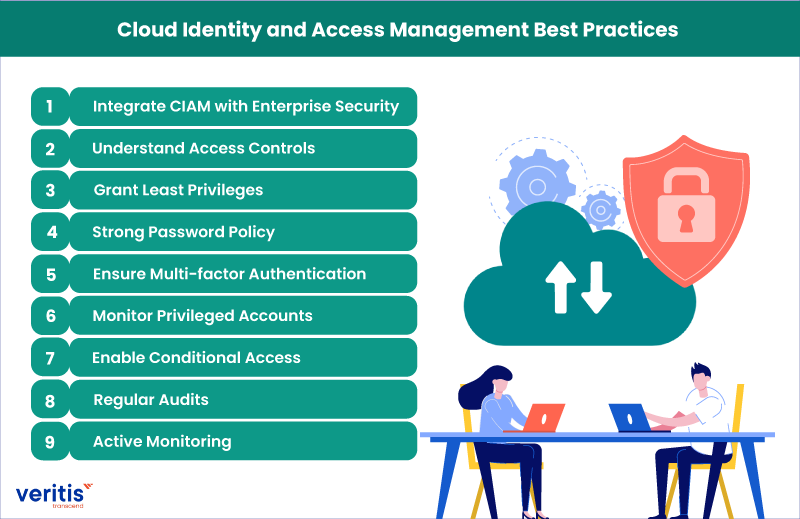
In recent years, most organizations have beefed up their efforts to harness the cloud. But there is one lingering hesitancy emphasized by many firms: Security.
When cloud security enigma is coupled with the complexities of hybrid or multi-cloud environs, organizations may go astray on their cloud journey. Fortunately, modern identity and access management (IAM) solutions have emerged as the panacea to the cloud security conundrum. The right IAM solution can help organizations navigate the cloud, securely.
A sound IAM strategy is crucial in securing cloud assets against malicious access. With the right IAM approach, organizations can identify, authenticate, and authorize users and provide user-specific access to cloud resources, services, and applications. Leading practices are still emerging around the use of cloud IAM.
Talk to Our Cloud Security Expert
Let’s dwell on some of the notable IAM best practices:
Cloud Identity and Access Management Best Practices

1) Integrate CIAM with Enterprise Security
Many organizations still rely on ‘security silos’ that leverage different strategies and technologies. However, this reliance can be counter-productive over time. Instead, organizations must hammer out an integrated security model. So, without further ado, integrate the cloud-based identity management solutions with enterprise security.
2) Understand Access Controls
Access management for cloud assets is vital. Organizations must understand who has access to cloud, the level of access, and what all possible tasks they can do with that access. Leverage AI and ML technologies to gain valuable insights into the processes that control access across your cloud environment. Use these insights to monitor your cloud and restrict malicious access and entitlement creep.
3) Grant Least Privileges
When forging the cloud IAM strategy, follow the ‘principle of least privilege’ to grant only the necessary permissions to perform the task. Scope out what level of access users need to perform their duty, and hammer IAM policies that enable them to perform only those tasks. It is wise to provide a minimum level of access permission at the start and grant additional permissions as required. Starting with permissions that are too lenient can be risky, and squinching them later can be challenging.
4) Strong Password Policy
Implement a robust password policy that obligates your users to create strong passwords and update them regularly. The policy must define password requirements, such as minimum length and characters to be used and how frequently it must be rotated. It is wise to automate a password change as most tend to ignore this aspect.
5) Ensure Multi-factor Authentication
Enforce multi-factor authentication (MFA) for all the users. Organizations that don’t implement extra layers of identity protection are more vulnerable to credential abuse attacks. A credential-based attack can lead to data compromise. This can be averted by MFA.
6) Monitor Privileged Accounts
Securing privileged accounts is the foremost step in protecting critical assets. Cybercriminals target these accounts to gain access to an organization’s sensitive resources. To secure privileged access, one must isolate the accounts from the risk of being exposed to a cyber attacker.
7) Enable Conditional Access
Your employees and clients may often access your cloud resources by using a wide variety of devices and apps, from any location. Therefore, organizations must ensure that these devices meet their security and compliance standards. Tailor access control policies based on conditions for accessing your cloud resources.
8) Regular Audits
Cybersecurity is ever-evolving. You must regularly review your cloud identity management framework and plan future security improvements. Regularly audit user credentials and track the lifecycle of passwords and access keys. The audits will shed light on the vulnerabilities that the cloud has.
9) Active Monitoring
Deploy an active identity monitoring system to help quickly detect suspicious activities and trigger an alert for a prompt response. Organizations must implement a method that identifies attempts to sign in from unfamiliar locations, infected devices, and suspicious IP addresses, among others.
As cloud adoption increases, IAM solutions will likely continue to gain popularity to address security conundrum. Many businesses appreciate the need for strong IAM strategy to deal with all their security demands. The mentioned best IAM practices can help you achieve robust identity and access capabilities in the cloud and create a secure cloud environment.
Concerned About Security in the Cloud? Veritis Can Help!

Veritis is a leading provider of cloud computing consulting services. Our team of experts helps organizations adopt the cloud securely and establish a security-first cloud strategy.
Veritis Cloud Identity and Access Management portfolio encompasses a wide range of services, including Compliance and Identity Management Readiness (CIMR), Privileged Access Management (PAM), and Cloud Identity Governance. Reach out to us to elicit the optimal cloud IAM strategy for your company and harness the full potential of the cloud.
More Articles:
- Best Practices that Lead to Good Cloud Governance
- Cloud Implementation Services: Strategy, Solutions and Benefits
- Cloud Computing in Healthcare: Looking for Security Advantage?
- How Cloud Computing Maturity Model (CCMM) Helps?
- Why Financial Sector Needs Identity and Access Management (IAM)
- Identity and Access Management (IAM) Market Forecast: USD 25 Billion by 2026
- IAM Implementation and Solutions To Emerging ‘IT Security Challenges’
